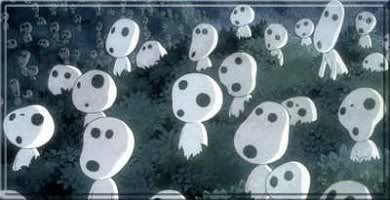
The forest sprites.
Why animation?
Nowadays, you can do just about anything with visual effects. Of course, many filmmakers will never realize the fatal flaw in this strategy: in using visual effects, they are making the audience aware of the fact that the 300 ft. tall giant elephants are CGI (after all, we know they're not real) and distracting them, and pulling them away from the film. When you see a 300 ft. tall elephant in a film, no matter how real it looks you think "oooh, what good CGI" and are seperated, in a way, from the film.
In an animated film, of course, no one has to worry about this, because everything is animated in the first place, and, interestingly enough, it seems more "real." I personally believe the whole point of animation should be to portray all that would be impossible with live action. That said, this is exactly why Princess Mononoke should be on anyone's top 100 movies list.
Like all Miyazaki films its quite sentimental, yet this one is also surprisingly dark. There would be no other way, of course, to portray mankind's destruction of nature.
Princess Mononoke tells the story of an epic war between man and nature, that, as we come upon it (during 14th century Japan) appears to be coming to a close.
We hardly have time to admire the beautiful watercolor painted landscapes before the film attacks us. An alarm is sounding around a small village and surrounding countryside. Our protagonist, Prince Ashitaka (who rides an elk named Yakkuru, who acts a lot like a dog) spies from a watchtower something strange moving in the woods. There is a brief suspensful moment before out bursts a mass of thousands of purplish worms that seem to surround a large animal. I add, if there is any part of the film that specifically gets it a PG-13 besides the violence...well, those worms are unsettling, to say the least. Make sure you aren't eating when they come on.
The worm-beast-thing (identified as a demon) attacks the village and Ashitaka kills it. In doing so, however, the demon puts a curse on him that will, over a period of time, eat away at his soul and kill him. As a village tradition, he cuts off his top knot and leaves his village, never to return. His goal is to find where the demon came from and how a ball of iron might have found its way inside it. He eventually arrives at Irontown, a very literally named fortress which produces the majority of iron used in Japan. Irontown is waging a war against a band of gods serving the Great Forest Spirit to protect the surrounding forest form logging and mining. Interesting how the only animals we see in the film are the ones who might be able to survive the longest. You have the wolves and the giant boars, who can fight, the apes, who can climb trees, and tiny forest sprites who rattle their heads as a friendly greeting. Well, they can just disappear at will.
Irontown is winning the war against the environment, but they soon also have to fight the emperor's samurai for their iron. The 'town is run by Lady Hiboshi, who seems generally cold and cruel, but has human touches here and there. She is willing to use her own fighters, who worship her, as human bait and drops bombs on their heads as a stampede of boars attack. On the other hand, she is one of the few people willing to take care of lepers, and employs them in her gunworks. She also helped buy women out of city brothels to help run the town. Ashitaka takes a tour of Irontown, then later a tour of the forest, whose representative in this case is a girl named "San," who is called "Princess Mononoke" by the Irontown residence (that's "Princess of the Beasts" to you). San was raised by wolves and seems drawn to the idea of putting a spear in Lady Hiboshi. It also happens she is around Ashitaka age. a-HEM.
Ashitaka runs back and forth: Why can't we all just get along? He makes quite an impression with all but his efforts are futile and make no difference in the long run.
This is Hayao Miyazaki's masterpiece. The man's trademark involves sequences of stunning imagination and visual beauty, and there's plenty to go around here. I particularily remember one scene where "The Great Forest Spirit" turning into a giant by moonlight and striding past the mountains, as millions of little forest sprites, sitting in the tops of the trees, rattle their heads as he passes by.
Princess Mononoke is a violent film. It aint The Wild Bunch but there are decapitations, limb losses, scenes that if adapted into live action would not look out of place in a Tarantino film. These scenes are, however, are brief, few, and scattered throughout the film. Don't take your kids to this film. It is not a kiddie film. I'm just sayin'!
The Japanese language version is considerably better than the English one - the Americans tend to overdramatize it Shakespeareanly, especially Minnie Driver, who makes something hilarious out of just saying "Fire!" (In a British accent: "Fiyahhhhhh!").
The music is by Joe Hisaishi, who has done all of Miyazaki's work since Nausicaa of the Valley of the Wind. He scores the film near perfectly. 'Nuff said.
If you are a human being, you will leave this film stunned. It is, in my ever so humble opinion, the greatest film of 1999, and one of the greatest films ever made.
P.S. I know its hard to take the anime fans seriously when they call this one of the greatest films ever made. Just ignore them and see this. You will be impressed.
No comments:
Post a Comment